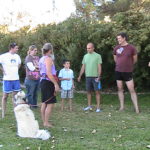I’ve heard some interesting arguments against barefoot running, for example “you couldn’t run a full marathon barefoot in Phoenix, Arizona, in July at noon – therefore barefoot running isn’t worth trying”…
Well, reasonable people wouldn’t run marathons (even in shoes) in Phoenix, in July, at noon either. That’s why Marathons in Phoenix are rarely, if ever, run in July at noon!
Anyway, the average temperature inside shoes is hotter than outside. It’s just that” frying pan” asphalt surface we need to be careful about how much time we spend on it … well, that and the fact that it’s might be really hot outside!
So, lift your feet quickly. If the pavement is really hot, lift your feet even more quickly! … and maybe try to get off the pavement, or at least onto cooler pavement in the shade.
Remember our soles are the proverbial canary in the coal mine, an essential part of our early warning system. Soles are extremely sensitive to warn us when we’re running badly, or at a bad time of day, or on the wrong surfaces for that time of day, for too far, and/or too often, too soon. These warnings are not simply to protect the feet, they protect the rest of our body from impact, excess or improper torque, and let’s include overheating too.
So, first thing to ask yourself when you soles are getting toasted, “is it too hot for you to run?” Not just for your soles, but for your body. Sometimes you simply should concede that running in extremely hot weather might not be something your body is ready for, yet, and your soles are simply trying to warn you to avoid too much, too hot, too soon.
However, just because it isn’t hot when you’re running, doesn’t mean the pavement hasn’t been warming up all through the day. Like in the evening of a very sunny spring day, the pavement can become much hotter than the overall weather would indicate.
In any case, there are limits to what our bare soles can do. And that isn’t a bad thing. It is usually a warning. After all, there are limits to what our body can do. And in all of my experience running barefoot, I find that what my soles aren’t ready for, my body isn’t ready for either. Sometimes, it’s simply time to take a break…
But, that doesn’t mean that we are simply incapable of extending those limits by improving our technique, and running smarter, or building up gradually over time, or that our feet are inadequate – that would be like saying that quality control inspectors are “too sensitive” because they don’t like it when we ship defective products from our factories to our customers. No, what it means is we need to figure out how to build better products that pass inspection.
We (our bodies) are the customers of our running (the product). Each step carries our body. And the quality control inspectors (our bare soles) will try to prevent us from shipping bad product (bad running technique). If we imprison the quality control inspectors (put them in shoes) so we can continue to run badly, without being made aware of it, the result could be, in the long term, serious damage to our body.
Summerizing Soles
That warning stated, each summer, there will be days in which the pavement becomes very hot, compared to other days in spring, and some of those days, the weather might not be nearly as hot as the pavement. On those days, limit how far you run, but don’t avoid the pavement all-together, as there is some conditioning (re-conditioning) needed each spring season. (what some of us have called “summerizing” our soles). As with any new activity that we haven’t done for months (over the winter), conditioning our soles for hot surfaces will take time, and several outings, and we should be careful to limit these outings to avoid blistering, as I don’t believe that healing blisters is any faster than a more conservative toughening without blistering approach.
In the meantime, when you are on hot pavement look for cooler options, at least occasionally; grass, lighter colored surfaces, painted white lines, dirt, and gravel – rough surfaces have more air between the points contacting the sole, and also encourage you to lift your feet more quickly (and not to push them into the ground harder). Make a point to pay attention to how your soles feel. Focusing on how far, or how fast, or how often you “need” to run can distract us from figuring out HOW to run, or When to seek shade on a hot day.
By June (or July depending on your climate), or December or January (depending on your hemisphere), if you’re using good technique (especially fast cadence), your bare soles should be able to run reasonable distances at reasonable times of the day without damage.
There also seems to be a tissue memory for this conditioning. Over the years, the conditioning can occur in progressively shorter and shorter periods each spring.
Posted in: Extremes

